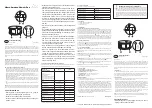
MIO-H29RRXS004270 Rev D
G&B Specialties Inc. 535 West 3
rd
Street, Berwick, PA, USA Tel: (570) 752-5901 Fax: (570) 752-6397
US Field Service: 570-441-6988; CAN Field Service 570-854-0482; www.rafna.com
-9-
13.
Fill the hydraulic system and bleed the air out:
a.
Fill the pump tank with DEXRON III (or equivalent) hydraulic fluid.
b.
Operate the front railgear up and down briefly to circulate the fluid and bleed
the system of air (refer to the Railgear Kit and Hydraulic Kit Operation, Service,
and Parts manuals for operation instructions).
c.
Refill the pump tank and repeat the above step until all air is removed from the
front hydraulic system.
d.
Operate the rear railgear up and down briefly to circulate the fluid and bleed
the system of air.
e.
Refill the pump tank and repeat the above step until all air is removed from the
rear hydraulic system.
f.
With both front and rear railgear locked in the road position, fill the pump tank
to the full line.
14.
Follow the Hydraulic System Relief Valve Setting procedure detailed in the Hydraulic Kit
Service section of this manual.
15.
Test the fit of the locking cable holding collar on both the front and rear locking cables.
Ensure that the locking cable holding collar keeps the railgear locking pin fully
disengaged. Grind the locking cable holding collar or adjust the locking cable handle on
the cable to fit if necessary. If cables are not present, test levers and rods for proper
function in the same manner.
16.
Test the operation of the controls and emergency pump operation. Refer to the
operation procedure in the Railgear Kit manual and Hydraulic Kit Operation section of
this manual.
17.
Locate and store the hand pump handle and the locking cable holding collar in a secure
location in the vehicle cab.
*Ensure that the thermal overload wires are properly spliced/connected as shown*
*It is recommended that a 200 amp fuse or a 200 amp circuit breaker be installed to isolate
the hydraulic pump from the vehicle electrical system as shown*






































